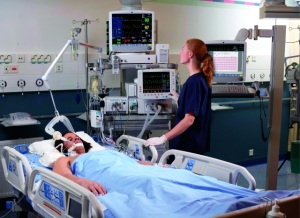por
Diana Bradley, Staff Writer | July 23, 2012

An ICU patient setting with
a GE CARESCAPE B850 Monitor.
From the July 2012 issue of HealthCare Business News magazine
Alarm management would improve if monitoring systems were integrated with pagers, mobile phones and other wireless devices. At June’s Association for the Advancement of Medical Instrumentation (AAMI) conference, the results of a 2011 nationwide survey on alarm management revealed that more than half of those surveyed agreed with this statement.
So, could integration be the solution to the growing “communication chaos” being witnessed in health care? Constantly generating updates, alerts and key pieces of information, a plethora of patient monitoring and other emergency management systems are inundating health care staff with hundreds of notifications every day. Unless this data is gathered and delivered to the right person at the right time on the proper communications device, experts agree it is useless. Hospitals are now working out ways to connect these disparate systems and rein in this communication cacophony, making life easier for clinicians and allowing for improved patient care and satisfaction.
“I wouldn’t call [communication chaos] a trend, I would just call it a reality given the amount of information systems, devices and technologies that come into play in patient care right now,” says Greg Rathmell, director of product marketing for patient monitoring systems and enterprise patient informatics at Philips Healthcare.
With the advancement of networking, wireless solutions and all the disparate technologies hospitals are trying to implement, a technology convergence is slowly but surely taking place. Integrating other sources of patient data with physiological monitors and alarm systems would help clinicians to better understand patient conditions and make sense of alarm signals. These sources include: electronic health records, lab data from multiple sources, combined data from different hospital units and data from other systems. But getting all of these systems to work and play nicely together can at times be challenging for hospitals, according to Allen Enebo, Spacelabs Healthcare’s global product manager for information management solutions.
“It’s just not a simple box solution any longer,” he explains. “You don’t just buy a monitor and use it. You buy a system and that alone is more complex by nature. Then, taking into account the needs of various stakeholders throughout the hospital – IT Clinical, biomed, finance – and how to integrate these to maximize your efficiency, adds to the equation.”
